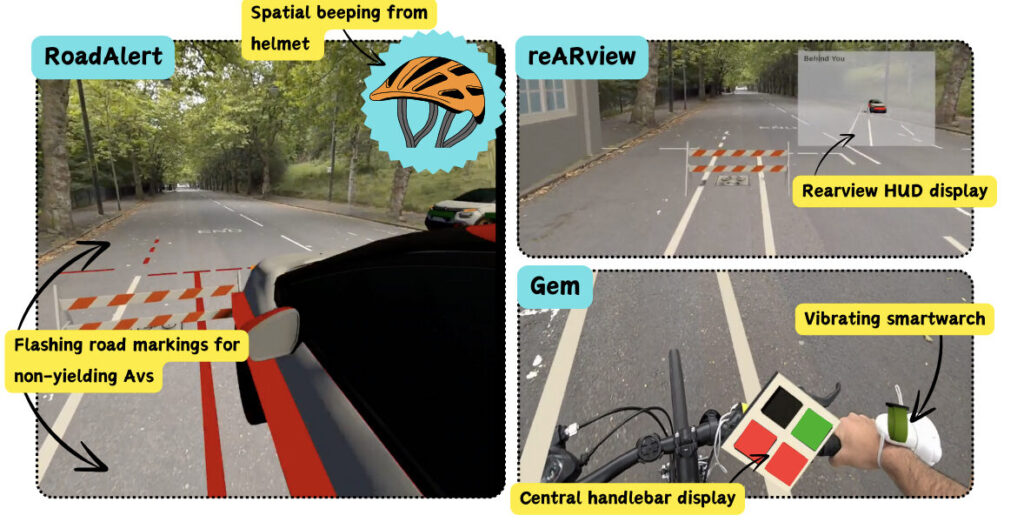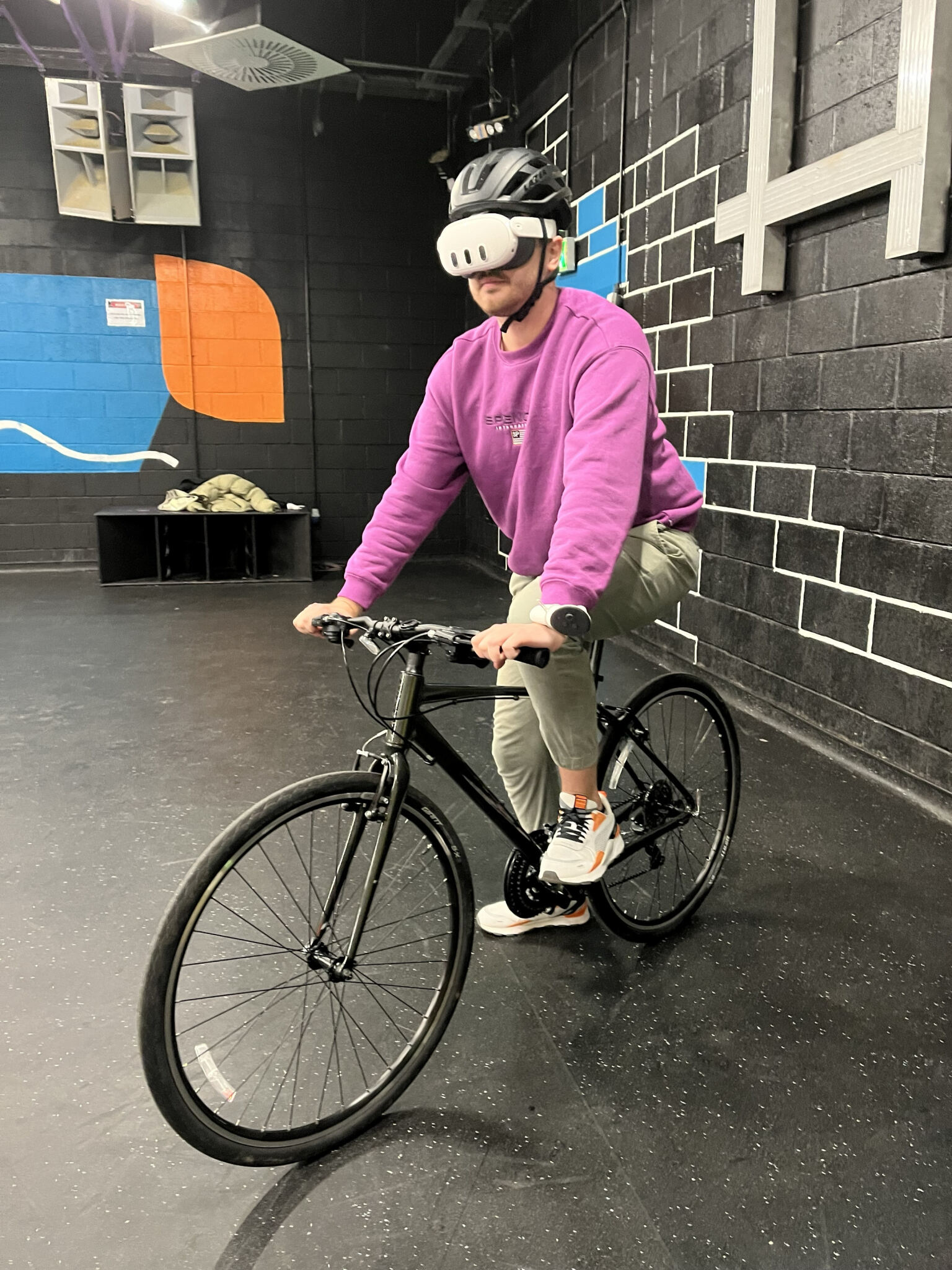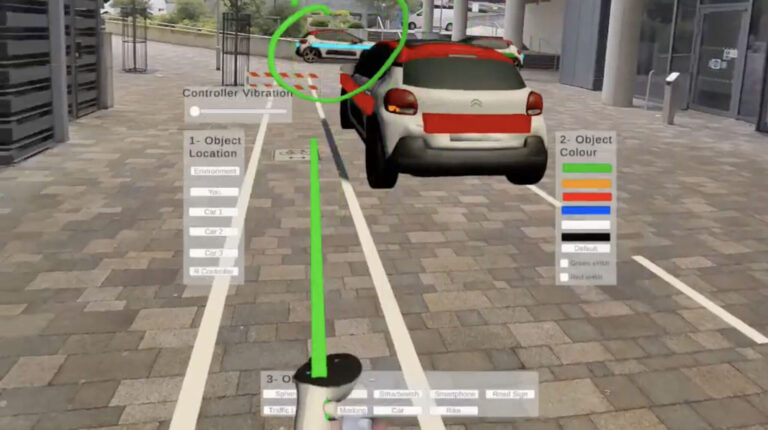A new tool that can rapidly prototype augmented reality experiences has given researchers new insights which could enable cyclists to safely share the roads with self-driving cars.
Researchers from the University of Glasgow developed the CycleARcade tool, which uses augmented reality headsets to enables cyclists to see and interact with simulated autonomous vehicles as they ride in real-world environments.
The team used CycleARcade to explore how new gear could equip cyclists with a “sixth sense” to help them be more aware of self-driving cars’ intentions. The researchers also examined how cyclists from different countries may expect different behaviours from autonomous vehicles on their local roads.
Unlike traditional simulators which use stationary bikes surrounded by computer screens to mimic real-world situations, CycleARcade enables a more realistic experience, where cyclists ride freely in open spaces with graphics of virtual vehicles displayed in their headsets. The system provides researchers with precise control over the virtual vehicles, enabling cyclists to safely test out immersive scenarios which could be dangerous on real roads with actual cars.
The team’s research builds on previous work it has conducted on how autonomous vehicles can communicate effectively with cyclists to replace the complex set of nods, waves and eye signals that human drivers and riders have developed to signal their intentions to each other. Their CycleARcade research will be presented as two papers later this month at the CHI Conference in Japan.
The first paper outlines how the Glasgow team used CycleARcade to test new designs for interfaces which could alert cyclists to nearby autonomous vehicles and provide information about the cars’ intentions.
With the help of a focus group of 20 cyclists, the researchers developed and tested three virtual displays which would give riders information about vehicles around them in different road scenarios where some cars would yield to the cyclists while others would not.
One prototype, RoadAlert, displayed signals about the cars’ intentions directly onto the road surface and played spatial audio beeps which got louder as vehicles approached. A second, called reARview, gave riders a virtual rear-view mirror through augmented reality glasses. The third, named Gem, used handlebar-mounted displays to communicate the virtual vehicles’ movements.

Ammar Al-Taie, from the University of Glasgow’s School of Computing Science and the paper’s lead author, said, “Technology offers an opportunity to augment cyclists’ awareness of the roads around them, providing a kind of ‘sixth sense’ to help them navigate safely.
“What we found in this study is that you don’t need to alert cyclists about all vehicles equally. Cyclists need focused awareness of vehicles that pose the greatest risk, like those approaching from behind or vehicles that won’t yield, while being able to maintain attention on the road ahead. RoadAlert was the design that brought those qualities together most effectively for our study participants.
“It’s important to emphasize, though, that we’re not expecting cyclists to have to adopt this kind of technology in order to stay safe on the roads in the future. Instead, we’re expanding the toolbox for cyclists who want additional support or awareness, who could choose to buy devices specifically designed to do so.”
In the second paper, computing scientists and psychologists from the University of Glasgow and colleagues from the KTH Royal Institute of Technology in Sweden show how they used CycleARcade to probe the road safety expectations of cyclists in three different countries, with very different levels of cycling infrastructure.
They gave CycleARcade kits to cyclists in cities in Sweden, Oman and Scotland and asked them to ride in simulated road conditions with computer-controlled projections of autonomous vehicles displayed in their headsets.
In Stockholm, where cyclists are used to having their own space in dedicated cycle lanes, riders wanted to know exactly where the self-driving car was located around them. They preferred to take their time to judge its intentions by watching its driving behaviour.
In Muscat, where cyclists regularly navigate busy shared roads and make fast-paced decisions about their next move, riders were more likely to quickly trust direct signals from the vehicles.
Cyclists from Glasgow, which has a limited number of dedicated bike lanes, took a more balanced approach. They reported that they wanted to see both location information and clear signals about the vehicle’s intentions.
“These findings clearly show that cyclists learn to share the roads with cars differently from country to country, which suggests that self-driving cars might need to adapt their communication methods to better speak the language of the local roads,” said Al-Taie. “Humans often do this naturally when driving abroad, but autonomous vehicles may need to have their programming tweaked to take local driving culture into account when they start rolling out around the world in the years to come.”
The paper has been selected by the conference for an Honorable Mention award, which is presented to the top 5% of papers submitted to CHI 2025.
CycleARcade is the latest development in research led by Professor Stephen Brewster, of the University of Glasgow’s School of Computing Science, which focuses on how cyclists can communicate with self-driving cars in the years ahead.
 Professor Brewster said, “Ultimately, we’re aiming to thoroughly explore the ways in which cyclists and autonomous vehicles can speak the same language on the roads to keep both as safe as possible. Human drivers and riders have developed a sophisticated series of signals to help decide who has the right of way or who has priority in a change of lanes, for example, and it’s vital that cyclists can have the same level of trust and understanding with self-driving cars.
Professor Brewster said, “Ultimately, we’re aiming to thoroughly explore the ways in which cyclists and autonomous vehicles can speak the same language on the roads to keep both as safe as possible. Human drivers and riders have developed a sophisticated series of signals to help decide who has the right of way or who has priority in a change of lanes, for example, and it’s vital that cyclists can have the same level of trust and understanding with self-driving cars.
“CycleARcade is a powerful tool to help explore how that new language can be developed, using real bikes in real physical spaces, with virtual elements that can be tweaked or replaced in real time. We’re continuing to work on research in this area, and we hope that our insights will help influence the design of future generations of autonomous vehicles.”
The team’s papers, titled, ‘Around the World in 60 Cyclists: Evaluating Autonomous Vehicle-Cyclist Interfaces Across Cultures’ and ‘evARything, evARywhere, all at once: Exploring Scalable Holistic Autonomous Vehicle-Cyclist Interfaces’, will be presented at the CHI Conference in Yokohama, Japan, on Monday, April 28, and Wednesday, April 30, respectively.


